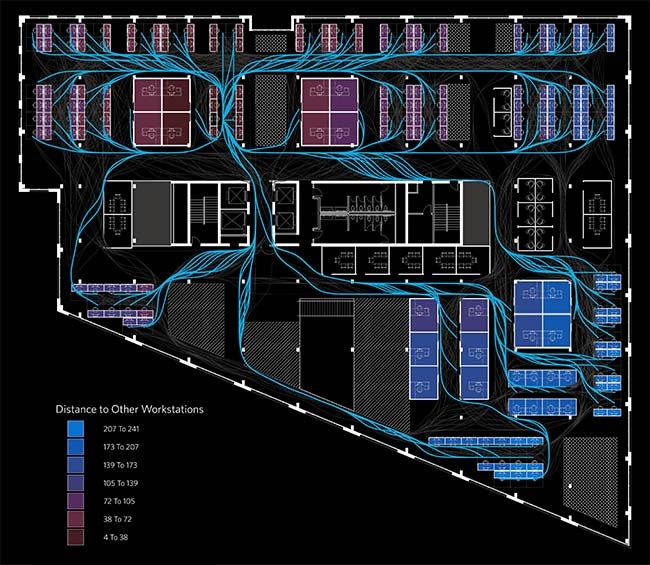
Designing for the Future of the Workplace: Using Spatial Metrics to Improve Human Outcomes
One size does not fit all in workplace design.
Workplace design is constantly evolving. We’ve experienced multiple generations of design ideas; concepts such as private versus open offices emerge and disappear as workplace design moves towards tailored solutions. What we’ve learned is that one solution doesn’t fit all.
Instead, the process of making design decisions for workplace environments has become a continuous effort in order to achieve the best results for each workplace setting. Every workplace project deals with a unique organizational culture, has unique financial terms, and should respond to its unique workforce. Furthermore, the best design solutions for today’s workforce isn’t necessarily the desired environment for the future generation of workers and their ever-changing work styles and technologies.
Three perspectives to consider when designing the future workplace:
- Investigate an organization’s culture, identity, limitations and workforce needs and tailor design decisions based on the human resources that will occupy the workplace environment. Some questions to ask: What are the organization’s primary values and goals? What constraints and cost limitations exist? What kind of work styles are common in the current work culture? What kind of work settings do we need for these work styles?
- Explore where the organization is heading and design flexible environments that can be modified and adjusted to needs of future generations. Questions to ask: How much growth can be predicted? What are the characteristics and needs of the future workforce needed to achieve and maintain that growth? What design solutions best respond to those needs? How can we design for flexibility and adaptation to future changes in technology and the work environment.
- Identify the potential impacts of design decision on human outcomes. Human capital forms the most significant part of each organization. By understanding the impact of spatial characteristics of workplace environments on human behavior, health and wellness and performance, we can provide desirable spaces that improve productivity and help maintain top talent. A review of workplace research highlights the correlation between spatial characteristics and human outcomes; that information, in turn, can be used to establish evaluation criteria for design options in order to achieve the best human outcomes.

Spatial metrics that were significantly correlated to human behavior, performance and health outcomes in workplace environments:
- likelihood of interactions
- collaboration
- communication
- innovation
- workplace satisfaction
- perception of privacy
- absenteeism
- alertness
- vitality
By evaluating different design options for their performance against selected spatial metrics, it’s possible to predict the potential building performance related to human outcomes to the extent supported by research evidence.
We’re now implementing a new way of understanding, planning and delivering the workplace experience, one that taps into research-based spatial metrics to rapidly design and test fit workplace concepts. We use existing architecture software and visual programming environments, along with custom data management tools, to simultaneously evaluate design options for their performance against multiple spatial variables, project costs and sustainability standards.
Through this process, our clients are making informed decisions at the earliest stages of the project. This method and custom tool set enables teams to work fast, be nimble and tailor the experience to each situation. By surfacing critical data related to occupancy, budget, and human performance and wellness simultaneously, we are creating the clearest and most complete business picture possible in order to drive decision making, improve space effectiveness, and enhance speed to market.



